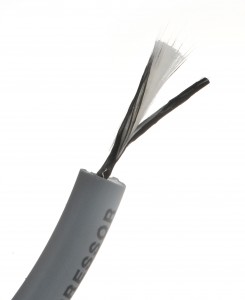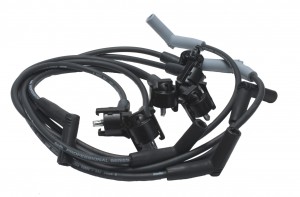When to change spark plug wires
When to change spark plug wires and how to test them
People often ask me why they should change spark plug wires. It’s a simple answer; they carry the firing voltage to the spark plugs and if they’re not performing up-to-par, neither are your spark plugs. You can spend top dollar buying the more expensive iridium spark plugs, but if you reinstall your old worn out spark plug wires, you’ll never get the performance you expected.
There are three types of spark plug wires; distributed resistance, inductance (MAG), and fixed resistor. Let’s talk about the differences between them before I talk about how to test and replace them.
Distributed Resistance Wires
Distributed resistance wires are made with a fiberglass core

Fiberglass carbon core of distributed resistance style spark plug wire
that’s impregnated with carbon and surrounded with silicone insulation. Carbon creates high resistance and that reduces radio interference (RFI) generated by the ignition coils. RFI can mess up radio reception and if it’s severe enough, it can interfere with sensor signals and computer operation. Distributed resistance type wires have a resistance value of 3,000 to 12,000 ohms per foot. U.S. Domestic car makers preferred this type for their vehicles
Japanese manufacturers, on the other hand, prefer inductance (MAG) spark plug wires. In fact, Honda, Acura, Toyota, and Lexus usually install MAG spark plug wires in their vehicles. MAG wires are made with a spiral wound core of copper/nickel allow wire. The reason for the spiral is that it creates a magnetic field and that field reduces RFI. MAG wires have far less electrical resistance and because of that, they require less current to fire the spark plug. If your vehicle came with MAG wires, you MUST replace them with the same type.
The third type of spark plug wire is the fixed resistor style. They’re made with a steel or copper core and a resistor located in the spark plug boot. If you car came with them, replace them with the same style.
Testing Distributed Resistance Spark Plug Wires
As I said earlier, distributed resistance type wires have a resistance value of 3,000 to 12,000 ohms per foot. To test them you’ll need an ohmeter. The actual value you get from testing each wire isn’t as important as the consistency between the wires. So if you test a 3-ft spark plug wire and get a reading of 10,000 ohms, all other 3-ft. wires should test the same. So if you find a wire with significantly less or more resistance, you know that it’s defective.
When to replace spark plug wires
You can test all you want, but spark plug wires don’t least forever. And when they fail, they cause misfires. That kills you gas mileage. But worse than that, those misfires can destroy your catalytic converter. And that can cost upwards of $1,200 to replace. So it makes no sense to try to squeeze more life out of old spark plug wires. And, since most later model car engines run almost 100,000 miles on a set of spark plug, it’s best to change the spark plug wires when you change the plugs.
What’s the difference between a good set of spark plug wires and an economy set
It’s all in the insulation. Premium spark plug wires are made with Ethylene Propylene Diene Monomer (EPDM) insulation and a second layer of Ethylene Vinyl Acetate (EVA) for better temperature resistance and strength. They include the exact same style factory coil boots and they match the factory set in length and fit.

This set of premium spark plug wires has factory style boots at the coil and plug end and the wire lengths make factory specification. Economy wires don’t have these features.
Economy spark plug wires, on the other hand, are made with cheaper insulation and have cheaper connectors and boots. They don’t fit well, and overall, they’re a bad choice.
How to replace spark plug wires
The biggest mistake DIYers make when replacing spark plug wires is not paying attention to proper routing. There’s a method to the madness when car makers insert their spark plug wires into the plastic “loom holders.” If you don’t follow their routing exactly, you can get “cross-fire.” That happens when the fire for one spark plug “induces” voltage onto the wire routed next to it because it’s either too close or routed wrong.
Also, DIYers often forget to apply dielectric grease to each end of the spark plug boot. Since the spark plug wires stay installed for a long time, boots installed without grease are almost impossible to remove. The heat literally welds them to the spark plug.
Spark plug wire replacement tip: To remove spark plug wires from the plug without damaging the boot or wire, use a spark plug boot puller tool instead of a pliers. Click here to see the tool I recommend
© 2012 Rick Muscoplat
Posted on by Rick Muscoplat
